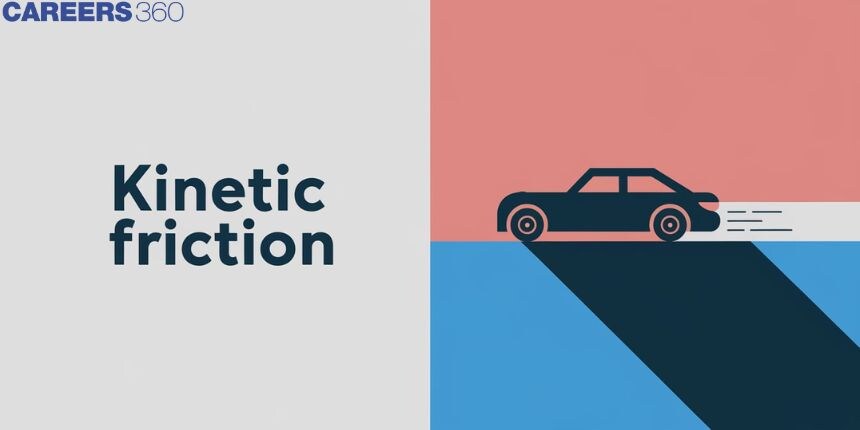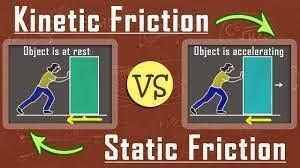Kinetic Friction - Definition, Types, Examples, FAQs
When we try to slide a body over a surface, the motion is opposed by a bonding between the body and the surface. This is caused by the electromagnetic forces between the charged particles at the surface and the body’s surface that is in contact. This resistance/opposition is represented by a force called friction. However, our topic of discussion is ‘Kinetic friction’ here. As we go further into the article, we will discuss what is kinetic friction and static friction, kinetic friction examples, kinetic friction formula, SI unit and dimensional formula of kinetic friction, coefficient of kinetic friction, work done by kinetic friction, differences between kinetic friction and static friction, and types of kinetic friction.
JEE Main/NEET 2027: Physics Important Formulas for Class 10
NEET 2025: Mock Test Series | Syllabus | High Scoring Topics | PYQs
JEE Main: Study Materials | High Scoring Topics | Preparation Guide
JEE Main: Syllabus | Sample Papers | Mock Tests | PYQs
- What is Kinetic Friction?
- SI Unit and Dimensional Formula of Kinetic Friction
- Coefficient of Kinetic Friction Formula
- Work Done by Kinetic Friction
- What is Static Friction?
- Differences Between Static and Kinetic/Dynamic Friction
- Derivation of Kinetic Energy Formula From Work-Energy Theorem
- Types of Kinetic Friction
- Factors Affecting Kinetic Friction
- Kinetic Energy Formula For Different Types of Motion
- Solved Examples Based On Kinetic Friction

What is Kinetic Friction?
Kinetic friction definition: Friction is of two types- static and kinetic friction, also called dynamic friction. The type of friction that acts when a body slides over a surface is called kinetic friction denoted by
The two surfaces are moving relative to each other. The magnitude of kinetic friction force usually increases when the normal force increases. That is why it takes more force to slide a box full of books across the floor rather than to slide the box when it is empty.

This principle is also used in braking systems i.e. the harder the brake pads are squeezed against the rotating brake disks, the greater the braking effect produced.
We can also define kinetic friction as when two bodies in contact with each other move concerning each other, rubbing the surfaces in contact, the friction between them is kinetic. The direction of kinetic friction is the opposite of the velocity of the body moving on the surface of another body.
SI Unit and Dimensional Formula of Kinetic Friction
The SI unit of kinetic friction is Newton (N) or
The dimensional formula of kinetic friction is,
Coefficient of Kinetic Friction Formula
The magnitude of kinetic friction depends on the normal force or the normal reaction acting between the two bodies. So we can write-
where,
Where N is the normal force/normal reaction and
Properties of Coefficient Kinetic Friction
- The coefficient of kinetic friction does not depend on the speed of the sliding bodies. However, this is true only for speeds that are not too large and are generally less than 10m/s.
- The coefficient of kinetic friction does not depend on the area of the surface in contact as long as the normal force N is the same.
- It is unitless and dimensionless.
- It depends on the nature and material of the two bodies in contact.
- It doesn't depend on the speed of the sliding bodies.
Kinetic friction examples include the friction that comes into play when anybody moves along a surface. We will discuss examples of kinetic friction alongside its different types.
|
Related Topics, |
Work Done by Kinetic Friction
As friction is force acting opposite to external force acting on the surface, this work done by a frictional force is nothing but a dot product of force with the displacement the body goes through.
In terms of kinetic friction,
Substitute
The angle
So,
Substitute the value of cos, we get
Simplifying
What is Static Friction?
Imagine we are trying to slide a heavy almirah on a horizontal concrete surface by applying a force F. This concrete surface is not an ideal frictionless surface. So, if this force F is small, the almirah remains stationary and the force that resists or counteracts F, not allowing it to move, is called static friction denoted by
See figure-3. (a), (b), (c) shows that when there is no relative motion, the magnitude of static friction fs is less than or equal to

For a pair of given surfaces, the maximum value of
Thus,
Thus ,
This maximum value of static friction,
Differences Between Static and Kinetic/Dynamic Friction
Kinetic friction acts when there is a relative movement between the surfaces of 2 bodies or a body and floor. However, static friction acts on a body when it is at rest.

-
Kinetic friction is always comparatively less than limiting friction, i.e.
-
The kinetic friction does not depend on the magnitude of applied force. However, static friction depends on the magnitude of force applied.
-
The value of static friction can be anything from 0 to limiting friction and thus it can be zero but kinetic friction cannot have a zero value.
-
Static friction opposes motion n of a body when it’s at rest and then gets max when it starts to slide but kinetic friction is the opposition provided to an already moving body.
Derivation of Kinetic Energy Formula From Work-Energy Theorem
Work done is given as,
According to work energy theorem,
From Newton's second law we get,
Work done over a small displacement
Since
Thus,
Integrating total work done,
By the Work-Energy Theorem, the work done is equal to the change in kinetic energy
Thus, the kinetic energy of the object at velocity
Types of Kinetic Friction
There are three types of kinetic friction generally- i) sliding friction ii) rolling friction and iii) fluid friction. Let’s discuss them one by one-
-
Sliding friction- This is the type of kinetic friction that comes into play when an object slides over a surface. It is of course weaker than the static friction. The formula for sliding friction is the same as the kinetic friction where F is the force of sliding kinetic friction and the constant of proportionality is the coefficient of sliding kinetic friction. Examples are- when a block slides up or down an inclined plane, rubbing of hands together, rubbing of a matchstick, etc.

Rolling friction- A spherical body or a circular ring rolls over a horizontal surface without slipping and at every instant, the body touches the surface at just one point and this point does not move relative to the surface. The friction experienced by the rolling body is called rolling friction and it is much smaller than sliding friction hence very little force is required to keep rolling a body even if it is heavy, as compared to sliding it through the floor. That’s why the invention of wheels is a major milestone in the history of mankind.
To further keep things smoother, lubricants are used in ball the bearings of many machines which reduces kinetic friction to a great extent. Examples – a suitcase on wheels, cartwheels moving on the floor, a bicycle or any automobile with wheels, etc.

Fluid friction- Both the sliding and rolling friction come into play in the case of solids but in the case of liquids and gases, fluid friction comes into play. At least one of the surfaces is that of a fluid. It is the friction between the layers of a fluid that moves on top of each other or relative to each other. This internal opposition is also called viscosity. However if a body flows on top of a liquid or inside a fluid (which can be gas or a liquid), the body also experiences fluid friction.

This fluid friction experienced by the body can be minimized by giving a streamlined shape to the body. This is why airplanes, boats, and submarines are made streamlined. Nature has given birds and fishes streamlined bodies so that they can easily move through fluids. Some examples of fluid friction are-


Factors Affecting Kinetic Friction
- The normal force
- Coefficient of kinetic friction
- Nature of the surface
- Speed of motion
- Temperature
Kinetic Energy Formula For Different Types of Motion
| Type of Motion | Kinetic Energy Formula |
| Linear Motion | |
| Circular Motion (Uniform) | |
| Rotational Motion | |
| Projectile Motion | |
| Vibrational Motion (Simple Harmonic Motion) | |
| Translational and Rotational Combined Motion |
Recommended Topic Video
Solved Examples Based On Kinetic Friction
Question 1. A block rolled on a rough surface with a velocity of 8m/s comes to rest after traveling 4m. Compute the coefficient of friction (
1) 0.8
2) 0.6
3) 0.4
4) 0.5
Solution
Given
The initial velocity of the block, u = 8 m/s,
Distance traveled before the block stops, s = 4 m
Let the coefficient of kinetic friction between the block and the surface be
F.B.D of the block-

From F.B.D
Assuming the acceleration of the block to be
The block stops
Applying 3rd equation of motion-
Question 2. The coefficient of static friction between two surfaces of the body depends
1) nature of surface
2) the shape of the surface in contact
3) area of contact
4) all of the above
Solution
Dependence of (
- Depends on material
- Nature of surfaces in contact
wherein
- It does not depend upon the apparent area of contact.
Friction force depends on the material and the nature of the surface in contact.
Hence, the answer is the Option (4).
Question 3. A rocket is fired vertically from the earth with an acceleration of
1)
2)
3)
4)
Solution
Kinetic or Dynamic Friction
Where:

Since the rocket is moving vertically upwards with an acceleration of 2g, the apparent acceleration experienced by the point object is g + 2g = 3g
Vertically downwards
where,
Hence, the correct option is 1.
Question 4. The upper half of an inclined plane with inclination
1)
2)
3)
4)
Solution
Kinetic or Dynamic Friction -
Where:
- wherein
For the upper half smooth incline, a component of g down the incline =

For the lower half rough incline, frictional retardation =
∴ Resultant acceleration
or
or
or
or
Hence, the correct option is 1.
Question 5. A smooth block is released at rest on a
1)
2)
3)
4)
Solution
Kinetic or Dynamic Friction
Where:
Wherein
Component of
∴ For a smooth plane:
For rough planes:
Frictional retardation up the plane

∴
or
Putting
or
Hence, the correct option is 3.
Also read:
Frequently Asked Questions (FAQs)
Coefficient of friction of water is way less than that of the floor because of which less friction is experienced and hence more motion happens. This can make people slip easily.
Sliding friction b) rolling friction c)static friction d) limiting friction
Answer-(b)
We can increase friction by increasing the roughness of the surface. This can be done by throwing sand over the surface.
Static friction
Friction in fluids can be making objects in streamlined shape.
Also Read
25 Jun'25 04:11 PM
23 Jun'25 10:52 PM
21 May'25 12:19 PM
05 Feb'25 04:38 PM
11 Jan'25 03:12 PM
03 Dec'24 04:00 AM
03 Dec'24 03:48 AM
29 Nov'24 11:10 AM
28 Nov'24 01:12 AM
27 Nov'24 11:57 PM

